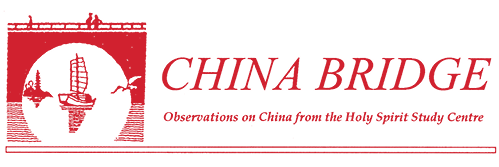
China Bridge (神州橋樑)_2009/Sep
Lei Feng, St. John Vianney and the Year of Priests
What do soldiers in the People’s Liberation Army (PLA) and Catholic priests have in common? Heroic role models such as Lei Feng (雷鋒) and St. Jean Vianney. The Year of Priests is a good time to compare and contrast these two overachievers.
The model Chinese soldier
Lei Feng (18 December 1940-15 August 1962) was born in Hunan (湖南) during the Japanese invasion. When he was seven-years-old, he was a hungry orphan who would have died if a PLA officer had not helped him. He grew up to become a farmer, not an intellectual. He volunteered for the army. With China’s vast population, admission standards were high. Lei Feng was short and underweight from early malnutrition. Yet he enthusiastically expressed his desire to serve and he convinced the recruiters to let him enlist. Later, he learned to drive and repair trucks.
Lei Feng fervently loved the Party, socialism and the people. Without the Party, he would have died in boyhood. His motto was, To live is to serve the people – live to make others happy. He helped children and the elderly cross a busy road safely, washed the feet of his comrades after a tiring march and darned their socks when they slept. Although he was friendly to a young woman, the relationship was strictly platonic. He kept busy serving the people and studying the thoughts of Chairman Mao instead of getting married. Then an accident claimed Lei Feng’s life.
His superiors read his diary and were impressed with his single-hearted devotion. Word spread quickly and, on 5 March 1963, Mao urged the nation to learn from the good example of Lei Feng (學習雷鋒好榜樣). His hometown opened a museum in his memory in October 1969. Visitors can see his simple clothes and his diary, and life-sized statues of him helping others. A second museum in Fushun, Liaoning (遼寧扶順), is more hi-tech. Lacking the original relics, it relies upon reproductions and photos of his personal items.
There have been renewed Learn From Lei Feng campaigns since the 1980s. According to their particular skills, on March 5, university students repair shoes, fix furniture or mechanical devices, or use sewing machines to mend old clothing. On most campuses, activities in imitation of him occur even today.
In posters he is shown holding his gun, wearing a padded army jacket and black winter cap, while looking up with courage and determination. Another common image shows him driving a truck, holding both the steering wheel and a book (by Mao, no doubt) balanced on it at the same time – not a good example of safe driving.
The model Catholic priest
Jean Vianney (May 8, 1786 – August 4, 1859) was born into a poor family. The French Revolution of 1789 and ensuing violence did serious injury to the Catholic Church. As a young man, he was drafted into Napoleon’s army but served only briefly. His inadequate schooling threatened his entry into the seminary. Once enrolled, he should have been expelled for his poor grades, but the bishop saw Jean’s sincerity and dedication, so he ordained him. In 1818, he was assigned to the small town of Ars, where he served for 41 years as the pastor, or curé (two syllables in French, cure-ray).
Jean Vianney lived an austere life, preached sternly against sin and urged all to strive for holiness. He said, “Only do what one can offer to God.” If something is unworthy of being done for God, it should not be done, period. He gave insightful, firm advice in the confessional. Penitents were so moved by the experience of confessing to him that they told their friends. As the years passed, his reputation spread. A new invention, the railroad, passed close to Ars. Crowds came from across France and later from across Europe, to see him. He finally spent almost all of his time in the confessional, getting only few hours of sleep.
He consoled penitents by telling them, “Some people say: I have done too much wrong, God cannot forgive me.” But this is a big blasphemy. This amounts to setting a limit to the mercy of God. But his mercy has no limit: it is infinite.”
When he was not in the confessional, he was on his knees before the tabernacle. He encouraged people to receive holy communion often, saying, “After we have received communion, if somebody asks us: ‘What are you bringing back home?’ we could answer: ‘the heavens’.”
The Curé of Ars is always depicted wearing his white robe. His hands are either holding a crucifix, or a rosary, but most often clasped in prayer. He was canonised in 1925, and his small church was rebuilt as a basilica.
Less zeal, less faith today
Louis Pasteur (1822-1895), a great French scientist, saved lives by keeping milk from spoiling (pasteurisation) and a vaccine for rabies. This devout Catholic came a generation after St. Jean Vianney, when France was becoming more urbanised.
Pasteur once said with a sigh, “Oh, for the faith of a Bréton peasant!” He saw how country people from that area, untouched by the Industrial Revolution, had great religious devotion, more intense than his own. Since Pasteur’s time, not only France, but also the entire western world has become much more secularised.
Chinese who were born a third of a century or more after Lei Feng are too young to remember the Cultural Revolution (1966-1976). They grew up in a China where “to get rich is glorious,” as Deng Xiaoping (邓小平) said; economic development comes first. It is hard for them to identify with the poverty of Lei Feng’s early years and his whole-hearted devotion to the Party. Especially for those with urban residency (户口), life is about making and spending money, acquiring education and status, and having a good time. Sacrifice and austerity sound like ancient history. Younger Chinese cannot identify with Lei Feng; if anything they find him a naïve, laughable figure. But whatever anyone wants to say about Lei Feng, he was not cynical and he lived for something bigger than himself.
Giving one’s heart to whom, or to what?
Pope Benedict XVI promulgated both the Pauline Year, which ended this June 29, and then the Year of Priests, which started June 19. The slight overlap was due to choosing the solemnity of the Sacred Heart of Jesus as the opening date. Despite human ingratitude, the mercy of Jesus remains available. “God’s heart calls to our hearts, inviting us to come out of ourselves.”
The pope draws our attention to a common feature in the lives of both St. Paul and St. Jean Vianney: they were “completely enthralled by Christ,” held captive by his love, and so they ministered with love and dedication in quite different settings.
In his general audience of June 24, Pope Benedict reflected on the sanctification of the priest, who is called to lose himself in Christ, “participating with his whole being in the mystery of Christ’s death and resurrection.” This demands self-denial, not so much to fulfill the function of serving a community, but to increase a vision of the sacred in life. The pope italicised three prepositions: the priest “is in Christ, for Christ and with Christ, at the service of humankind.” This is a clear call for full-hearted commitment.
In the early 1950s, staff in some Chinese offices cut out paper hearts, signed their names and posted them on a bulletin board to symbolise “giving one’s heart to the Party.” During the Anti-Rightist Campaign of 1958-1959, accused people were urged to “bare their hearts to the Party,” confess everything and plead for mercy. However, little mercy was shown. That campaign was followed by the disastrous Great Leap Forward and not much has been heard since about giving one’s heart away.
Praying for priests and vocations
On July 11, over 2,000 people, including 44 of the 50 diocesan priests, gathered for Mass to mark the opening of the Year of Priests in Beijing. Bishop Li Shan presided. He urged his priests to place a high demand upon themselves, not only upon the laity, to pay attention to what they do and say, to celebrate the sacraments with reverence, and to read the scriptures daily.
Who will help priests live up to these high standards? Everyone at that Mass was given a booklet with the names, photos and short biography of each priest in Beijing, plus a prayer to say for them.
In Hong Kong, the stress is on vocations. Hong Kong is an ageing city and the average age of the diocesan clergy, religious sisters and brothers is likewise steadily increasing. Changes in society have a deep impact upon the Church. For many reasons, the birthrate has been extremely low since before 1997. This will impact on seminary enrollment before it will affect the size of the labour force and the economy of the territory.
On 21 February 2005, chief executive, Donald Tsang (曾蔭權) called upon Hong Kong couples to have three children per family. The response was minimal even before the financial tsunami. Marriage is a big commitment and commitment is a scary word in modern society. Raising children is an even bigger commitment and expense.
However, the bishop of Hong Kong has one resource at his disposal which the chief executive lacks: prayer. Bishop Tong has called upon his constituency to pray for vocations. The decline will not reverse itself without prayer, but “more things are wrought by prayer than this world dreams” (Alfred Tennyson, 1809-1892).
The difference prayer makes
When many people tell a priest they are praying for him, he feels affirmed and is encouraged to take a few more steps along the road which St. Jean Vianney heroically travelled. If people had been praying for him, how much more could Lei Feng have accomplished?
The Year of the Priest will run until 19 June 2010. Activities are just getting underway. In several months, China Bridge will have an update on the Year of the Priest in China.
MJS


 ENG
ENG